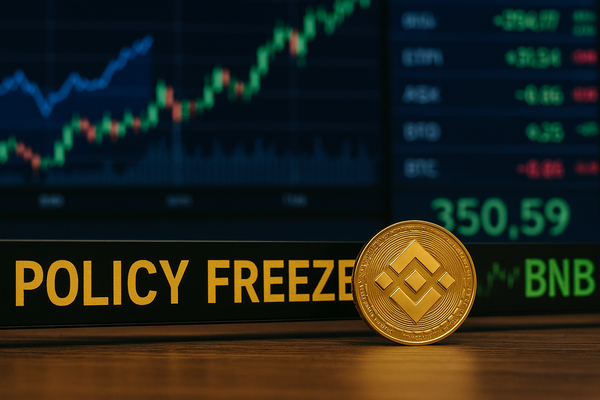
U.S. crypto policy vacuum is the market’s top driver today. Regulatory momentum has stalled as Washington slows, while BNB breaks away from peers on utility and funding flows. Short term, the government shutdown and reduced agency staffing raise backlogs and mute catalysts. Long term, the fate of market-structure and stablecoin rules will shape capital formation and institutional participation. In the U.S., clarity risks slipping into election season; in Europe, policymakers consider new sanctions tied to a ruble-backed stablecoin, underscoring global divergence. Compared with prior cycles, the policy torque that once pushed adoption is weaker, but corporate actions and chain activity are filling the gap. That’s why timing matters now: the next few weeks could lock in 2025’s regulatory path.
The single biggest driver: Policy inertia in Washington
The most important factor driving crypto markets today is the policy vacuum in Washington, intensified by the government shutdown. The White House has gone quiet since releasing a broad framework in July, and Congress faces a narrowing window to move market-structure legislation before electioneering takes over.
The House-passed Clarity Act is parked in the Senate Banking Committee, while Senate leaders float a discussion bill and the Agriculture Committee readies its own draft. Market commentary indicates that without executive pressure, timing slips threaten to push comprehensive rules into 2026 or beyond.
Regulators are trying to bridge the gap. The SEC’s chair outlined Project Crypto with an innovation exemption targeted by year-end, while the CFTC launched a crypto sprint and opened paths for certain foreign venues. However, reduced staffing due to the shutdown raises the odds of a regulatory backlog. That matters for traders because fewer approvals, slower guidance, and delayed no-action relief translate into thinner near-term catalysts and lower confidence in compliance pathways.
Why it matters now: policy clarity historically precedes deeper institutional flows. If Congress misses this window, the next cycle of capital formation may migrate to jurisdictions moving faster. That has implications for U.S.-listed companies building crypto products and for liquidity onshore versus offshore.
BNB’s breakout and what the tape is telling us
Market report: exchange tokens are not broadly rallying, yet BNB is up almost 50% over the past month, according to market data. Activity on BNB Chain is surging, while a $1 billion ecosystem fund announced by Binance’s founder concentrates attention and flows. The chain’s fee-burn mechanism continues to retire supply, adding a structural bid in theory as usage expands.
Mechanically, exchange tokens function like loyalty chips. Users gain fee discounts and perks, which can reinforce platform stickiness. As prices rise, the cost to achieve meaningful fee reductions increases, which can cap incremental demand from new users—unless ecosystem utility and funding offset the cost pressure. That appears to be happening in BNB’s case.
Key developments shaping the tape:
- U.S. policy freeze: White House quiet; market-structure bills stalled in the Senate; government shutdown slows agency work.
- Regulatory projects: SEC innovation exemption targeted by year-end; CFTC crypto sprint and coordinated posture with the SEC.
- BNB leadership: ~50% monthly gain; ecosystem fund; rising on-chain activity; continued token burns.
- Institutional re-engagement: Morgan Stanley (NYSE:MS) allows advisors to recommend up to a 4% bitcoin allocation in opportunistic portfolios, according to reports.
- Venture and payments flows: Citi Ventures, part of Citigroup (NYSE:C), backs BVNK in cross-border stablecoin payments; Block (NYSE:SQ) introduces a new bitcoin payments option for Square users.
- Europe watching stablecoins: EU policymakers consider sanctions on a ruble-backed stablecoin, signaling tighter nets around non-dollar rails.
Takeaway: the market is rewarding tokens with visible utility, funding support, and activity metrics. In contrast, assets dependent on U.S. policy progress lack fresh catalysts until Congress or the agencies move. Expect dispersion to persist.
What investors should do now: catalysts, checklists, and risks
Actionable checklist (informational, not advice):
- Policy calendar watch: Track Senate Banking and Agriculture Committee schedules for any markup dates. If a markup is set, expect higher beta in U.S. crypto-exposed equities and compliant infrastructure names, with potential catch-up trades.
- Agency signals: Monitor the SEC’s innovation exemption timeline and any CFTC staff speeches or advisories. A concrete pilot or sandbox update could support liquidity for compliant platforms.
- BNB Chain internals: Follow daily active addresses, transaction fees, and burn reports. Sustained on-chain growth plus the new fund argue for continued attention; weakening activity would challenge the recent outperformance.
- Institutional flows: Watch for copycat moves after Morgan Stanley (NYSE:MS). Statements from other wirehouses or RIAs could signal incremental demand. Keep an eye on custody and risk frameworks disclosed to clients.
- Payments adoption: Assess throughput, merchant incentives, and take rates tied to Block (NYSE:SQ) rolling out bitcoin payments. Transaction growth here can be a real-world demand signal for liquidity and fee revenue.
- Stablecoin policy risk: European action on ruble-linked stablecoins could ripple into liquidity pools and cross-border corridors. Treasury and EU updates matter for basis traders and payment processors.
Why you should care: policy timing and corporate adoption are setting the trading range. In the short run, the shutdown and Senate delays weigh on U.S. onramps and listings. In the long run, a durable framework could re-rate compliant venues and tokens with clear utility. International moves—especially in Europe—may redirect flows and create relative-value opportunities between U.S. and offshore markets.
Downside risks and uncertainties:
- Legislative drift: If Congress misses year-end, the market-structure debate may restart post-election, extending uncertainty well into 2026.
- Agency backlog: Staffing and shutdown fallout could slow approvals, no-action letters, and pilot programs, dampening near-term catalysts.
- Concentration risk: BNB’s rally is tied to one ecosystem’s funding and activity. A reversal in usage or policy scrutiny on exchange-linked tokens could unwind gains quickly.
- Sanctions spillovers: New European restrictions on specific stablecoins could fragment liquidity, raise compliance costs, and introduce cross-border settlement frictions.
- Execution risk: Institutional allocation headlines can lag actual allocations; implementation, compliance, and custody issues may temper inflows.
Bottom line: The tape says policy vacuum first, utility second. Until Washington restarts the rulemaking engine, expect dispersion led by tokens with demonstrable usage and capital support. Keep your focus on calendars, chain activity, and corporate integration updates; those are the triggers most likely to move prices in the next leg.












